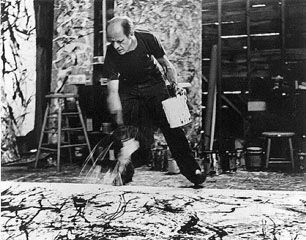"Is he the greatest living painter in the United States?" This headline, published in a 1949 article of Life magazine spotlighting the then-unknown Jackson Pollock, seemed to be more rhetorical than serious. The idea that "a painter who made his pictures by flinging pigment from cans of store-bought commercial paint at unstretched canvas rolled out flat on the floor" could be considered the best the USA had to offer seemed, at least at the time, absurd. We know now that history has vindicated Pollock and cemented him as one of the great artists of the 20th century. I was drawn to Pollock because I had heard he was "great" - but what exactly about his works, which upon first glance seem to be random splatters of paint on canvas, elevated him to his current status? This curiousity - and an itch that there was something profound behind the erratic drips and streaks - ultimately fueled an interest to gain a greater understanding of Pollock and his paintings.
Pollock was born as Paul Jackson Pollock on January 28, 1912 in Cody, Wyoming, and was reared in Arizona and California. However, upon moving East in 1930 to join several of his brothers at New York's Art Students League, he would never return permanently to his Western home. Despite developing an unshakable preference for the East, Pollock still had a "definite feeling for the West", and these influences would play a role in his paintings.
Nobody knows exactly when or why Pollock decided to focus on a sustained and deliberate exploration of creating an entire composition by dripping or pouring paint. But when he returned to this technique four years after his initial foray, he carried with him a logic and control indicative of newly developed maturity and independence. Jackson Pollock was dissatisfied with the interruptions to free movement from having to reload his brush, and so developed a method that allows him to create a continuous line by tilting a commercial can of thinner and paint, that would run down a stick placed in the can.
Pollock approached "painting the same way he approaches drawing", that is, "direct", Pollock would elaborate that "the more immediate, the more direct - the greater the possibilities of making... a statement". Early on, critics would say about Pollock's paintings something you might hear today: that you could "make yourself" one of Pollock's paintings because it seemed so disordered and erratic. People were not attuned to such unconventional ways of painting.
References
Landau, Ellen G. Jackson Pollock. New York: Abrams, 1989.
Print.
Pollock, Jackson. Jackson Pollock, New-found Works. New Haven: Yale U Art Gallery, 1978. Print.







No comments:
Post a Comment